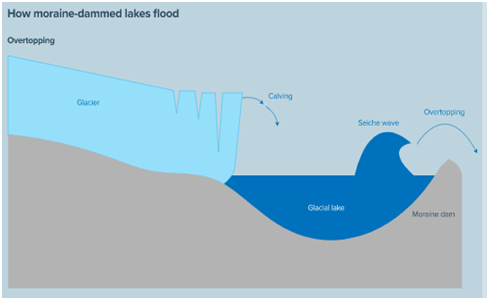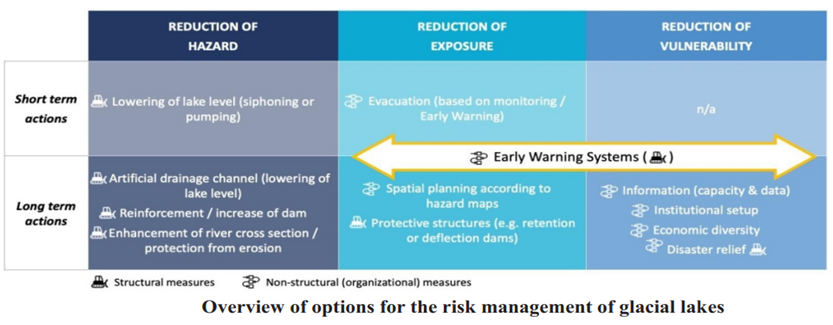What’s in Today’s Article?
- Why in News?
- What are Glacial Lakes?
- What are the Causes Behind GLOF?
- How did South Lhonak Lake Become Susceptible to GLOF?
- Did the Sikkim Government take any Action to Tackle the Expanding South Lhonak Lake?
Why in News?
- At least 10 people have been killed and 80, including 23 Army personnel, are missing in Sikkim after the South Lhonak Lake – a glacial lake situated in the state’s northwest at 17,000 ft – burst due to incessant rains.
- This resulted in the rise of water levels in (downstream areas) Teesta River that caused flash floods at least in four districts of Sikkim (Mangan, Gangtok, Pakyong and Namchi).
What are Glacial Lakes?
- Glacial lakes, like the South Lhonak Lake, are large bodies of water that sit in front of, on top of, or beneath a melting glacier.
- As they grow larger, they become more dangerous because glacial lakes are mostly dammed by unstable ice or sediment composed of loose rock and debris.
- In case the boundary around them breaks, huge amounts of water rush down the side of the mountains, which could cause flooding in the downstream areas. This is called glacial lake outburst floods (GLOF).
What are the Causes Behind GLOF?
- GLOF can be triggered by several reasons, including earthquakes, extremely heavy rains and ice avalanches.
- As these lakes are often found in steep, mountainous regions, landslides or ice avalanches can sometimes fall directly into the lakes and displace the water, causing it to over-top the natural dam and flood downstream.
- In 2013, one such event took place in Uttarakhand’s Kedarnath when the region witnessed flash floods along with a GLOF caused by the Chorabari Tal glacial lake, killing thousands of people.
How did South Lhonak Lake Become Susceptible to GLOF?
- With the rising global temperatures, glaciers in Sikkim Himalayan have been melting rapidly, giving rise to many glacier lakes and expanding the already existing ones in the region.
- According to the Sikkim State Disaster Management Authority (SDMA), there are currently more than 300 glacial lakes in Sikkim Himalayan, and 10 (including South Lhonak Lake) have been identified as vulnerable to outburst floods.
- Lhonak has grown nearly 1.5 times and South Lhonak nearly 2.5 times their initial size in 1989.
- An earthquake of magnitude 4.9 in 1991 near the parent glacier feeding the South Lhonak Lake and the recent earthquake (6.9) in 2011 may have weakened the boundaries of the lake.
- The recent incessant rains have led to the burst of the lake.
Did the Sikkim Government take any Action to Tackle the Expanding South Lhonak Lake?
- The glacier lake has been under observation by government authorities for years now.
- In 2016, members of the Sikkim SDMA and Sikkim’s Department of Science and Technology and Climate Change decided to syphon off lake water from the South Lhonak Lake.
- The technique was implemented under the supervision of innovator Sonam Wangchuk.
- Authorities installed three 8-inch wide and 130-140 metres long High-Density Polyethylene (HDPE) pipes and syphoned off 150 litres of water per sec.
Q1) What are flash floods?
A flash flood is caused by heavy or excessive rainfall in a short period of time, generally less than 6 hours. Flash floods are usually characterized by raging torrents after heavy rains that rip through river beds, urban streets, or mountain canyons sweeping everything before them.
Q2) What are the measures for flood control in India?
By afforestation, fury of flood could be minimized by planting trees in the catchment areas of rivers. Restoration of the original drainage system, which is generally choked by the construction of roads, canals and railway tracks.
Source: Glacial lake outburst flood kills 10 in Sikkim: What is GLOF, and why does it happen?
Last updated on January, 2026
→ Check out the latest UPSC Syllabus 2026 here.
→ Join Vajiram & Ravi’s Interview Guidance Programme for expert help to crack your final UPSC stage.
→ UPSC Mains Result 2025 is now out.
→ UPSC Notification 2026 is scheduled to be released on January 14, 2026.
→ UPSC Calendar 2026 is released on 15th May, 2025.
→ UPSC Prelims 2026 will be conducted on 24th May, 2026 & UPSC Mains 2026 will be conducted on 21st August 2026.
→ The UPSC Selection Process is of 3 stages-Prelims, Mains and Interview.
→ Prepare effectively with Vajiram & Ravi’s UPSC Prelims Test Series 2026 featuring full-length mock tests, detailed solutions, and performance analysis.
→ Enroll in Vajiram & Ravi’s UPSC Mains Test Series 2026 for structured answer writing practice, expert evaluation, and exam-oriented feedback.
→ Join Vajiram & Ravi’s Best UPSC Mentorship Program for personalized guidance, strategy planning, and one-to-one support from experienced mentors.
→ UPSC Result 2024 is released with latest UPSC Marksheet 2024. Check Now!
→ UPSC Toppers List 2024 is released now. Shakti Dubey is UPSC AIR 1 2024 Topper.
→ Also check Best UPSC Coaching in India



















